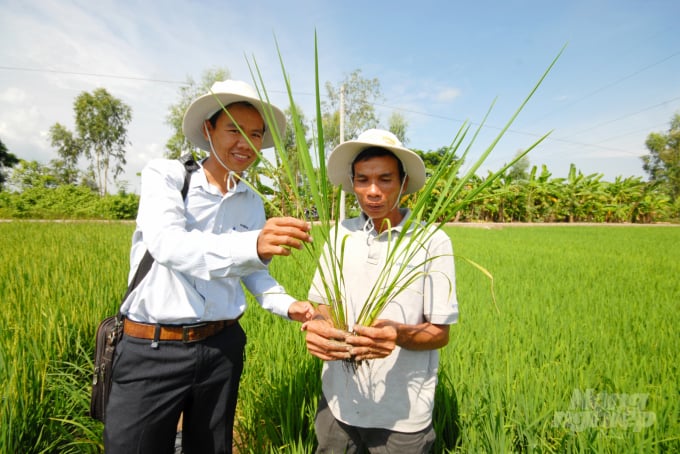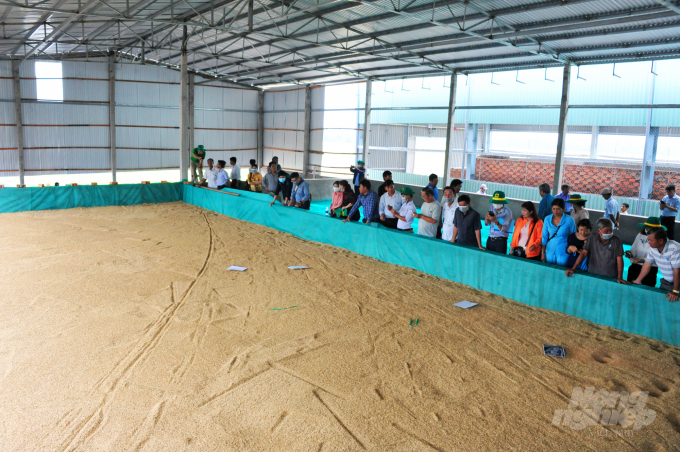June 20, 2025 | 14:17 GMT +7
June 20, 2025 | 14:17 GMT +7
Hotline: 0913.378.918
June 20, 2025 | 14:17 GMT +7
Hotline: 0913.378.918
An Giang and Dong Thap are two neighbouring provinces in the Mekong Delta with large rice production areas, these two localities can contribute nearly 8 million tons of rice on average each year. In order to have a high rice output and meet increasingly strict quality requirements for consumption and export, farmers must be increasingly "skilled" in production, proficiently apply advanced scientific and technical methods.

Farmers in the VnSAT project supporting the training in advanced techniques for rice production. Photo: Le Hoang Vu.
An Giang and Dong Thap provinces have recently been selected to receive investments of billions of dong by the VnSAT Project as support for the sustainable development of the rice industry for farmers, cooperative groups, cooperatives, etc. through training courses in rice cultivation techniques including: "3 decrease, 3 increase", "1 must 5 decrease", alternating between flooded and dry irrigation, etc. as well as support for agricultural equipment and materials.
Over the past 5 years, the VnSAT project to support Mekong Delta farmers in rice cultivation has resulted in 20-25% higher efficiency in terms of productivity, significantly reduced costs and increased profits to 10-15%. Products are made with high quality, stable output because of the businesses' consumption, farmers are very excited and assured to focus on rice production.
Tan Dong Agricultural Cooperative in My Phu Dong Commune, Thoai Son District (An Giang) has an area of nearly 800ha specializing in rice production. Over the past 3 years, the cooperative has been supported by the VnSAT project in training technical processes for rice cultivation including "3 decrease 3 increase", "1 must 5 decrease" as well as equipment and materials support for rice cultivation. As a result, over 95% of farmers in the cooperative have successfully applied the "1 must 5 decrease" technique, especially in seed reduction (from 300 kg/ha to 110-120 kg/ha).
With the application of these technical processes and the investment support from the VnSAT project in equipment and materials for production, the rice production of Tan Dong Agricultural Cooperative has gradually improved in terms of quality over the years. Productivity, quality, costs are significantly reduced while consumption is very favorable.

After 5 years of the VnSAT project implementation, efficiency of rice production in many areas has been 20-25% higher in terms of yield, with significantly reduced costs while profits increased by 10-15%. Photo: Ngoc Thang.
Mr. Le Van Chinh, Director of Tan Dong Agricultural Cooperative said: In the past, members of the cooperative mainly produced following old farming practices, the amount of seed sown was high, at about 300 kg of seed/ha due to the high sowing density.
Although some households are members of the cooperative, they receive rice consumption and technical support from businesses; however, transportation, especially road traffic, faces many difficulties because they all have to depend on the waterways. The distinct characteristic of the rice industry is that the products must be transported as quickly as possible to the drying warehouse when harvested, if delayed, the quality of the rice will be affected and will not meet export standards. Therefore, when the harvesting season comes, there are often not enough means of transport (mainly rafts) causing farmers to not have a stable income when producing rice.
Ever since the VnSAT Project supports Tan Dong Agricultural Cooperative in all aspects, in addition to organizing training courses on technical advances in rice cultivation, the project also supports dredging canals and upgrading roads to transport materials, rice and goods to the fields more conveniently. Since the 2020 winter-spring crop, the cooperative has collaborated with Loc Troi Group to purchase different rice varieties including Dai Thom 8, OM5451, IR50404, OM3830, Loc Troi with an area of 167 ha and an output of 1,500 tons.
Mr. Le Van Chinh, Director of Tan Dong Agricultural Cooperative happily added: The VnSAT project implementation in the area has contributed to improving the rice farming capacity for farmers, building a stable raw material area for rice export companies. Additionally, the project promotes the construction of in-field traffic works, creating favorable conditions for farmers to cultivate rice in the area. The economic life of people both inside and outside the project area has improved markedly.

The timely support of infrastructure resources has helped rice production cooperatives in the Mekong Delta improve production capacity and increase profits. Photo: Le Hoang Vu.
Farmer Nguyen Van Hai, a member of Tan Dong Agricultural Cooperative, said: “I came here from Nui Sap town (Thao Son district) to make a living since 1984. The locals here wish to have a clean and dry road for students to go to school and for farmers in the area to transport rice. That life-long cherished dream of such a road has been supported by the VnSAT Project. After receiving technical training from the project, I have reduced the amount of seeds when sowing to 100 kg/ha, rice has very few pests and diseases, the yield is stable, and the income from every crop is profitable.
According to the VnSAT An Giang Project Management Board, the project has been implemented since the autumn-winter crop of 2016 in 45 communes across 5 districts including Chau Phu, Thoai Son, Tinh Bien, An Phu and Tri Ton with the participation of 26,000 farming households. The project's goal is to support 18,000 ha of rice cultivation to farmers who successfully applied the advanced farming techniques of "3 decrease, 3 increase", " 1 must 5 decrease" and have 5,600 hectares of product consumption linkage, thereby increasing income for rice farmers by 30%.
Mr. Doan Ngoc Pha, Deputy Project Manager of VnSAT An Giang, said: the project has recently carried out the transfer of advanced farming techniques following the processes of "3 decrease, 3 increase" and "1 must 5 decrease" for 23,000 rounds of farmers through 750 training courses on an area of 35,500 ha. In addition, the project implemented 100 demonstration sites to serve training courses on rice cultivation techniques. As recorded in the communes participating in the Project, most farmers have significantly reduced the amount of rice sown, fertilizers, pesticides, thereby increasing their income on average by 22.3%.

The traffic works supported by the VnSAT project promptly solve difficulties for the transportation of rice and agricultural products, as well as make daily commute more convenient over time, marking an important contribution to the construction of new rural. Photo: Le Hoa.
In Dong Thap, in the period of 2016 - 2021, the VnSAT Project implemented a demonstration model following the "3 reduction, 3 increase" and "1 must 5 decrease" techniques in 6 northern districts of Dong Thap province, Afterwards, the model was evaluated as effective and is currently being replicated by farmers.
The local agricultural sector in Dong Thap, also implementing this model, has organized 566 training courses with over 20,000 farmers participating, built 75 farming models following "3 decrease, 3 increase" and "1 must 5 decrease" techniques on a 140ha area, with 100 farmers participating. The application area of "3 reduction, 3 increase" and "1 must 5 decrease" techniques for the entire project is 24,232 ha (accounting for nearly 5% of the province's rice cultivation area).
The application of high technology to rice production has helped farmers reduce the amount of seed to only about 8 kg/labour, the average yield is 7-8 tons of fresh rice/ha, and the production cost is reduced by 45-50% compared to the traditional farming methods, ensuring high profits for farmers.
Mr. Vo Thanh Ngoan, Deputy Director of Dong Thap Department of Agriculture and Rural Development, said: The VnSAT project implemented in Dong Thap province has covered the rice production chain, technical training of "3 decrease, 3 increase" and "1 right, 5 down" techniques; establishment of demonstration sites; investment in infrastructure and equipment for farmers to connect cooperatives with businesses and form complete linkage chains.
The highlight of the project is to guide farmers in gradually producing in a safe direction, with traceability, and improve the value of rice, in line with current market trends. It is encouraging that farmers currently implementing the model have gradually changed their production mindset, actively built their own rice brand, significantly increased income from production in the direction of adapting to climate change.
Translated by Nguyen Hai Long
![Turning wind and rain into action: [9] Digitizing hydrometeorological data in response to climate change](https://t.ex-cdn.com/nongnghiepmoitruong.vn/608w/files/news/2025/06/17/z6704423696987_15fd32ffc26d590d204d520c9dac6786-nongnghiep-165943.jpg)
(VAN) Farmers have begun accessing hydrometeorological applications to adjust their cropping schedules, aiming to ensure productivity and adapt to climate change.
![Turning wind and rain into action: [8] Real-time salinity detection and early warning technology](https://t.ex-cdn.com/nongnghiepmoitruong.vn/608w/files/news/2025/06/17/z6704423696987_15fd32ffc26d590d204d520c9dac6786-nongnghiep-151127.jpg)
(VAN) Thanks to the integration of modern hydrological-hydraulic models, remote sensing technologies, and artificial intelligence, the accuracy of hydrological forecasting has significantly improved.
![Turning wind and rain into action: [7] Early disaster warnings help marine farmers minimize losses](https://t.ex-cdn.com/nongnghiepmoitruong.vn/608w/files/news/2025/06/17/z6704423696987_15fd32ffc26d590d204d520c9dac6786-nongnghiep-142942.jpg)
(VAN) In recent years, thanks to early disaster warnings and forecasting, marine farmers in Khanh Hoa province have been able to reduce risks and losses, thereby improving production efficiency.
![Turning wind and rain into action: [6] ‘Four on-the-spot’ disaster management software](https://t.ex-cdn.com/nongnghiepmoitruong.vn/608w/files/news/2025/06/17/e5a48259d6a262fc3bb3-nongnghiep-183800.jpg)
(VAN) By simply activating the scenario on the disaster management software, the relevant authorities immediately know how many households need to be evacuated, where to evacuate them to, and by what means of transportation…
![Turning wind and rain into action: [5] Hue applies modern technology in disaster forecasting](https://t.ex-cdn.com/nongnghiepmoitruong.vn/608w/files/news/2025/06/17/z6704423696987_15fd32ffc26d590d204d520c9dac6786-nongnghiep-093938.jpg)
(VAN) In Hue city, modern technology has recently been applied in meteorological and hydrological forecasting and warning, helping to reduce the damage caused by natural disasters.

(VAN) A cutting-edge farming technique being implemented on an experimental ranch in Arizona's Sonoran Desert has already saved a billion gallons of water over five years, according to Civil Eats.

(VAN) Poultry and pig production and the environment can be boosted through enhanced water technology, according to new research.